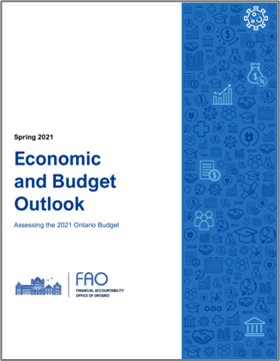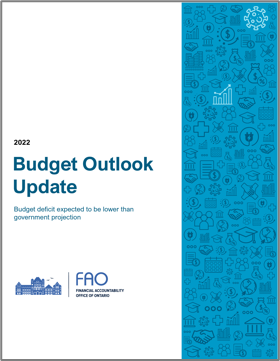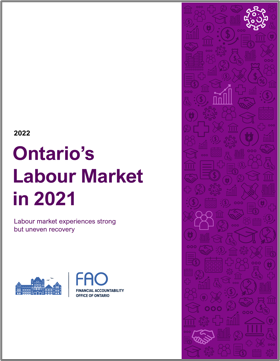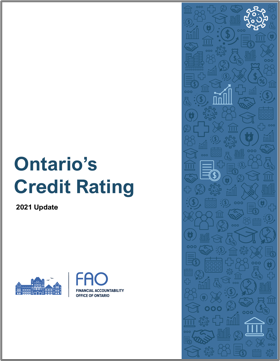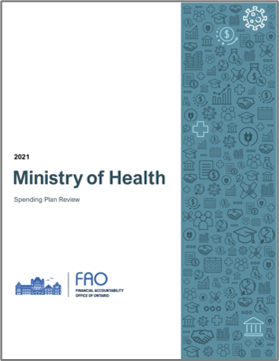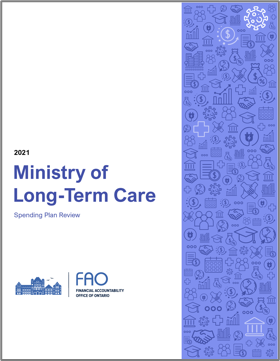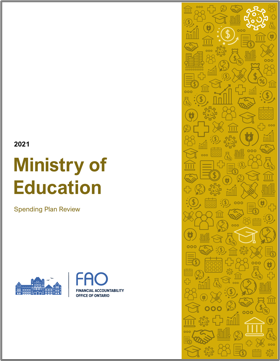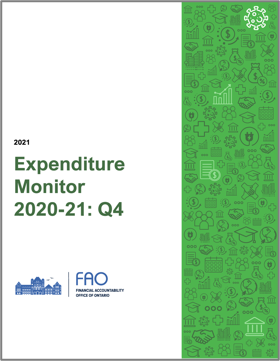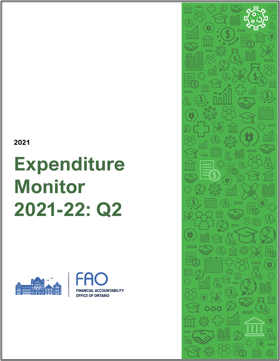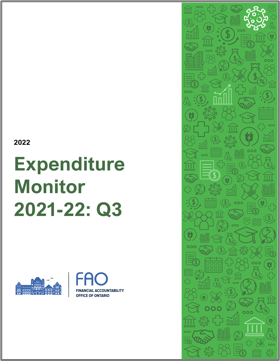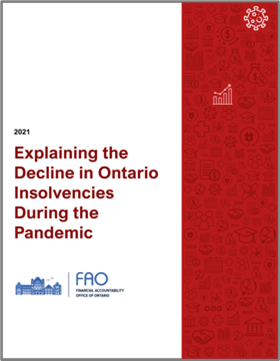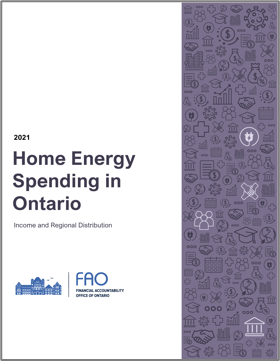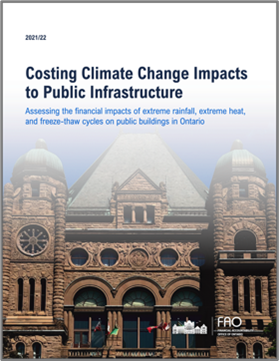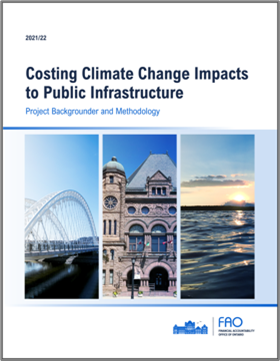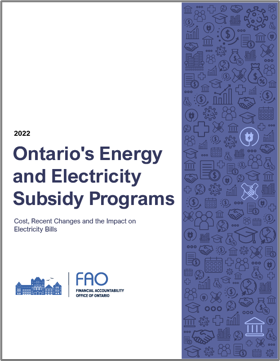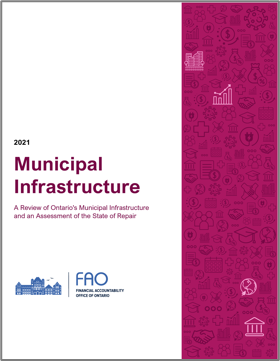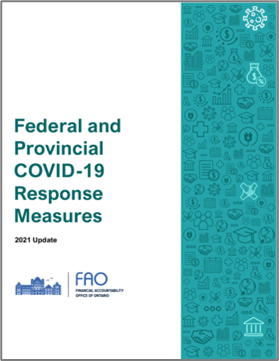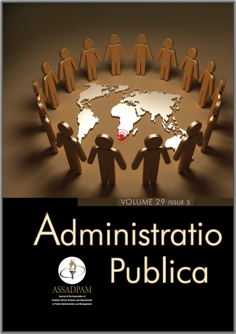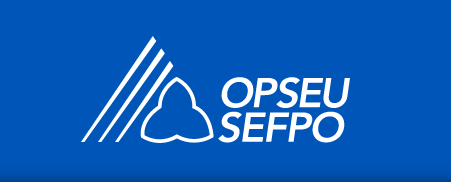July 28, 2022
The Honourable Ted Arnott
Speaker of the Legislative Assembly of OntarioMain Legislative Building, Room 180
Queen’s Park
Toronto, Ontario
M7A 1A2Dear Mr. Speaker:
In accordance with section 14 of the Financial Accountability Officer Act, 2013, I am pleased to present the 2021–22 Annual Report of the Financial Accountability Officer for your submission to the Legislative Assembly at the earliest reasonable opportunity.
Sincerely,

Peter Weltman
Financial Accountability Officer
OFFICER’S NOTE
Governing is complicated. It involves making choices that will affect people’s lives. And then it involves spending public money to bring those choices to fruition. The last two years really drive home this point. We have seen substantial government activity in response to the global COVID-19 pandemic and, with it, large amounts of public spending, which will have a lasting impact today and into the future.
So what does that have to do with the FAO? Our office “keeps score.” We provide independent forecasts of government revenue and spending plans, the costs of existing or proposed government programs, and analysis of trends in the provincial economy that could affect the government’s finances over the medium and longer term. This analysis helps MPPs ask the government informed, timely and pertinent questions about how Ontario is governed. And these questions – from MPPs, the public and the media – are how we help keep our government accountable.
When I accepted the position of FAO, my goal was to position the Office as the trusted, independent and non-partisan authority on Ontario government finances. This is my fourth year as the Financial Accountability Officer, and we have come a long way towards that objective. We know that information and analysis from our reports find their way into questions during Question Period, as well as into policy proposals by stakeholder groups. During the recent election, our Economic and Budget Outlook report, published before the campaign started, was acknowledged as the “pre-election” baseline for the government’s future fiscal balance, and many election promises from all parties were measured against that baseline.
To be the authoritative and trusted source of information and insights on Ontario government finances, the FAO aims to provide clear explanations of our work, continually monitor government policy, offer timely reports, and innovate to cover important emerging issues.
We do our best to explain. Our work on the impact of provincial spending and revenue collection on Ontario families helped families understand what they gain from provincial programs and services, after accounting for the taxes they pay. Our report on electricity subsidy programs explained how the government intended to meet its commitment to reduce electricity prices by 12 per cent, which the government never clearly articulated. Our reports covering Ontario’s Expenditure Estimates explained how the government intended to spend the funds requested from MPPs for three ministries – Health, Education and Long-Term Care – and the implications of these spending plans. Through our reports, we provide MPPs, stakeholders and the public with a better understanding of government finances and Ontario’s economy.
We constantly monitor. Our quarterly Expenditure Monitors provide up-to-date information on actual spending by the government, which alerts MPPs to government programs facing significant under- or overspending. Our labour market report highlighted the large employment swings during the pandemic experienced not only at the provincial level but in specific regions, updating MPPs on trends affecting their constituencies. Our interprovincial comparisons report compared Ontario’s finances with those of other provinces, showing MPPs Ontario’s relative fiscal standing in Canada. Our work monitoring Ontario’s finances and economy provides MPPs with up-to-date information for asking questions and undertaking initiatives that affect Ontarians now and in the future.
We strive to innovate. I was curious to test our capabilities as a small office to produce “first of its kind” analysis of select impacts of climate change. Our report on the cost of climate impacts on public infrastructure was a multi-year initiative that sought to project the costs of maintaining $250 billion worth of provincially and municipally owned building infrastructure in a state of good repair in light of increased wear and tear caused by climate change. This report, one of the first of its kind anywhere, has attracted attention from municipalities across the province and the country, other American cities and states, as well as international organizations, such as the Organisation for Economic Co-operation and Development and the International Federation of Accountants, and private sector organizations, such as engineering consulting firms and insurance companies.
I am very lucky to be surrounded by a terrific team of 20 people who are not only highly capable and highly motivated, but also a lot of fun to work with. This team’s professionalism and dedication made all this possible. I would also like to acknowledge the effort undertaken by the executive branch, including ministries and public entities, who provide the FAO with access to requested data as legally required.
As always, we remain committed to providing continued support to MPPs, external organizations, members of the media and Ontario’s citizens with a neutral, non-partisan voice on the current economic and financial issues affecting our province.
MANDATE AND ACTIVITIES
Overview
Established by the Financial Accountability Officer Act, 2013, the Financial Accountability Office (FAO) provides independent analysis on the state of the Province's finances, trends in the provincial economy and related matters important to the Legislative Assembly of Ontario.
The Financial Accountability Officer is an independent, non-partisan officer of the Legislative Assembly. The Officer’s primary role is to support Members of Provincial Parliament (MPPs) as they perform their constitutional function to review and approve the government’s spending and taxation plans. To do this, the FAO provides MPPs with timely, relevant and authoritative economic and financial analysis.
The FAO delivers its analysis to MPPs in the form of public reports, presentations, videos and infographics, all of which are posted to the FAO’s website and social media channels to increase accessibility and awareness.
The FAO’s Work
The FAO’s mandate is to provide independent analysis of the Province’s finances, including the budget and trends in the provincial economy. Work is undertaken in response to requests from MPPs or legislative committees, or on the initiative of the Financial Accountability Officer under several broad themes:
- Ontario’s economic and fiscal performance
- Government spending plans
- Financial analysis of specific government policies
The FAO released 21 reports in 2021-22 on a broad range of topics in line with the mandate of the organization. The ongoing impacts of the COVID-19 pandemic continued to be reflected in the FAO’s work.
Ontario’s Economic and Fiscal Performance
The FAO provides semi-annual forecasts of Ontario’s economy and financial position through its Economic and Budget Outlook (EBO) reports. The FAO’s Economic and Budget Outlook, Spring 2021 highlighted the severe decline in economic activity in 2020 due to the COVID-19 pandemic but projected a strong recovery in the two years following, driven by progress in vaccinations, improving global demand, and ongoing monetary and fiscal policy support. The FAO’s Budget Outlook Update provided an updated projection of the government’s fiscal position over the 2021-22 to 2023-24 period, projecting smaller deficits than the government’s outlook in the Fall Economic Statement due to stronger revenue growth.
Every two years, the FAO releases a Long-Term Budget Outlook report, which provides a projection of Ontario’s economy and fiscal position over the next 30 years, based on current policies. This year, the FAO released its third long-term report entitled Long-Term Budget Outlook, Assessing Ontario’s Fiscal Sustainability: 2021-2050. The report found that Ontario’s finances will be manageable over the 2020s as its fiscal position improves, but fiscal flexibility would become constrained over the longer term as ongoing health care pressures boost program spending growth above revenue gains.
The FAO also released several reports in 2021-22 that examined important economic and fiscal trends in Ontario. The FAO’s Ontario Labour Market in 2021 report noted that the province experienced a very strong but uneven job recovery from the COVID-19 pandemic, with some groups, industries and major cities remaining below pre-pandemic employment levels. The FAO’s Ontario’s Credit Rating: 2021 Update report found that while Ontario’s credit rating remained unchanged through the pandemic, other provinces were downgraded, resulting in Ontario moving from the sixth to the fifth highest rated province.
Government Spending Plans
In the spring of 2021, the FAO released three Spending Plan Review reports evaluating the Ministry of Health, the Ministry of Long-Term Care and the Ministry of Education. The purpose of these reports was to support the Standing Committee on Estimates’ review of the ministries’ Expenditure Estimates. The reports included a financial overview of each ministry, an analysis of key financial issues, and a review of proposed 2021-22 spending by program.
The FAO’s quarterly Expenditure Monitors assist MPPs in tracking provincial spending and changes to program budgets within the fiscal year. In the past, changes to the spending plan and actual spending results were only disclosed in the Public Accounts, limiting MPPs’ ability to review and scrutinize the government’s in-year spending. In addition to program spending, these reports tracked transfers from unallocated funds to support COVID-19-related spending measures and other government programs.
Financial Analysis of Specific Government Policies
At the request of MPPs or legislative committees, or on the initiative of the Financial Accountability Officer, the FAO provides financial analysis of specific government policies.
The FAO released the following report in 2021-22 in response to a request from the Standing Committee on Finance and Economic Affairs:
- Explaining the Decline in Ontario Insolvencies During the Pandemic assessed the impact of the COVID-19 pandemic on insolvencies in Ontario, noting that ongoing economic challenges related to the pandemic could lead to an increase in insolvencies over the medium term, depending on the extent and pace at which government support is phased out.
The FAO released the following reports in 2021-22 in response to questions or requests from MPPs:
- Home Energy Spending in Ontario: Income and Regional Distribution examined home energy spending and government subsidy programs across household income levels and regions in Ontario, noting that in 2019, the average Ontario household spent $2,128 on home energy, with high income and rural households receiving the largest electricity subsides.
- Costing Climate Change Impacts on Public Infrastructure (CIPI), a first-of-its-kind report, estimated the cost of climate change impacts from extreme rainfall, extreme heat and freeze-thaw cycles on public buildings in Ontario. The Project Background and Methodology report provided details on how the FAO estimated the costs of climate hazards on Ontario’s public infrastructure. In 2022-23, the FAO will release additional climate impact reports that focus on public transportation and public wastewater and stormwater infrastructure.
- Ontario’s Energy and Electricity Subsidy Programs examined Ontario’s nine energy and electricity subsidy programs, their cost over 20 years, and their effect on electricity bills of Ontario households and businesses. The report also estimated the cost of changes to the subsidy programs since the introduction of the Fair Hydro Plan in 2017 and identified how the Province planned to achieve its commitment to reduce residential electricity bills by 12 per cent.
- Municipal Infrastructure provided a review of Ontario’s municipal infrastructure and an assessment of its state of repair, estimating the backlog cost of bringing municipal assets into a state of good repair at $52 billion in 2020.
- Federal and Provincial COVID-19 Response Measures: 2021 Update reviewed the measures implemented by the provincial and federal governments in response to the COVID-19 pandemic, identifying 128 federal measures and 118 provincial measures, for a net total of $170.3 billion in support from 2019-20 to 2022-23.
USE OF THE FAO’S WORK
Overview
As the FAO strives to earn a reputation as the trusted source for independent analysis of Ontario’s finances and trends in the provincial economy, we continue to focus our outreach on MPPs while also connecting with new audiences. That means using multiple platforms to extend the FAO’s visibility to stakeholders and constituents who are looking for a neutral, non-partisan voice to assess the impacts of government policy on the province’s fiscal and economic position.
Members of Provincial Parliament
The FAO’s primary role is to support MPPs as they perform their constitutional function to review and approve the government’s spending and taxation plans. The FAO provides MPPs with timely, relevant, and authoritative economic and financial analysis, helping them ask the government informed, timely and pertinent questions. These questions help keep our government accountable.
The FAO’s 21 reports released in 2021-22 were specifically targeted to assist MPPs by explaining government programs and economic issues, and monitoring government financial performance and economic trends. To provide tailored support to MPPs, the FAO held 21 MPP briefings in 2021-22, held individual meetings, and responded to MPP queries.
To determine the effectiveness of our outreach, the FAO tracks both the frequency of mentions in the legislature, and the context in which a report was used. In 2021-22, the FAO was mentioned 154 times in the Ontario Legislature; in other words, 49 per cent of all sitting days included a mention of the FAO, down from 60 per cent in 2020-21. Critically, each political party used data from our reports to defend or scrutinize government policy, reflecting the FAO’s success in carrying out its mandate as a neutral, non-partisan office.
“Mr. Speaker, what the FAO confirmed is that 20,800 [child care] spaces are on track to be built. We are well on track by 2023-24 to meet our commitment of 30,000.” - MPP Lecce
“Speaker, this morning the Financial Accountability Office issueda report that talks about the surgical backlog here in Ontario. In fact, the [Financial Accountability Officer] said this: It’s a 419,200 surgery backlog that we have right now in this province as well as 2.5 million people waiting for diagnostic procedures as of this September alone.” - MPP Horwath
“According to the FAO second quarter expenditure monitoring, this government did not spend $838 million purposed for children and social services this past quarter.” - MPP Hunter
“The FAO estimates that the impact of climate-fuelled extreme weather events will cost an additional $6 billion this decade on buildings alone and $116 billion this century on buildings alone.” - MPP Schreiner
Stakeholders
The importance of the FAO’s work is evident when looking beyond the legislature to key stakeholders and community organizations who use data from our reports to advocate for their cause. Over time, the FAO has been increasingly recognized nationally and globally as our brand awareness continues to grow. In 2021-22, 24 publications cited the FAO including:
- Association of Southern African Schools and Departments of Public Administration and Management
- Canadian Medical Association Journal
- Review of Accounting Studies
- International Journal of Cancer
- Institute of Public Administration in Canada
Several key stakeholders also cited FAO reports in pre-budget submissions during public consultations ahead of the 2022 Ontario Budget. These submissions advocated for topics related to the Low-income Individuals and Families (LIFT) Tax Credit, teacher compensation, investments in climate adaptation, hospital capacity, and healthcare spending. In 2021-22, 10 notable organizations used data from FAO reports to strengthen their pre-budget submissions, including:
- Daily Bread Food Bank
- Elementary Teachers’ Federation of Ontario
- Ontario Chamber of Commerce
- Ontario Council of Hospital Unions
- Ontario Public Service Employees Union
General Public
The FAO incorporates a range of communications tactics to engage with the public in a meaningful way. This includes strategic outreach through earned media, social media and our website. Our goal is to structure information to best suit audiences on each platform, whether through a carefully constructed news release for the media, video/infographic for social media, or a central portal on our website.
Earned Media
Figure 1: Media hits

The FAO was mentioned in the print media 5,800 times in 2021-22 (Figure 1). This is down from a peak of 7,610 mentions last year, when we produced a record 24 reports. Many of the reports published in 2021-22 were either triggered by or related to the COVID-19 pandemic. As highlighted in the word cloud (Figure 2), FAO reports were frequently mentioned in the media when covering pandemic-related issues, such as the backlog for elective surgeries and diagnostic procedures.
Media coverage of FAO reports extended beyond Ontario, with news captured in British Columbia, Quebec, Manitoba, Nova Scotia and Yukon. Although the FAO’s work looks at the Ontario context, it remains relevant to other jurisdictions (Figure 3).
Figure 2: News mentioning "FAO"
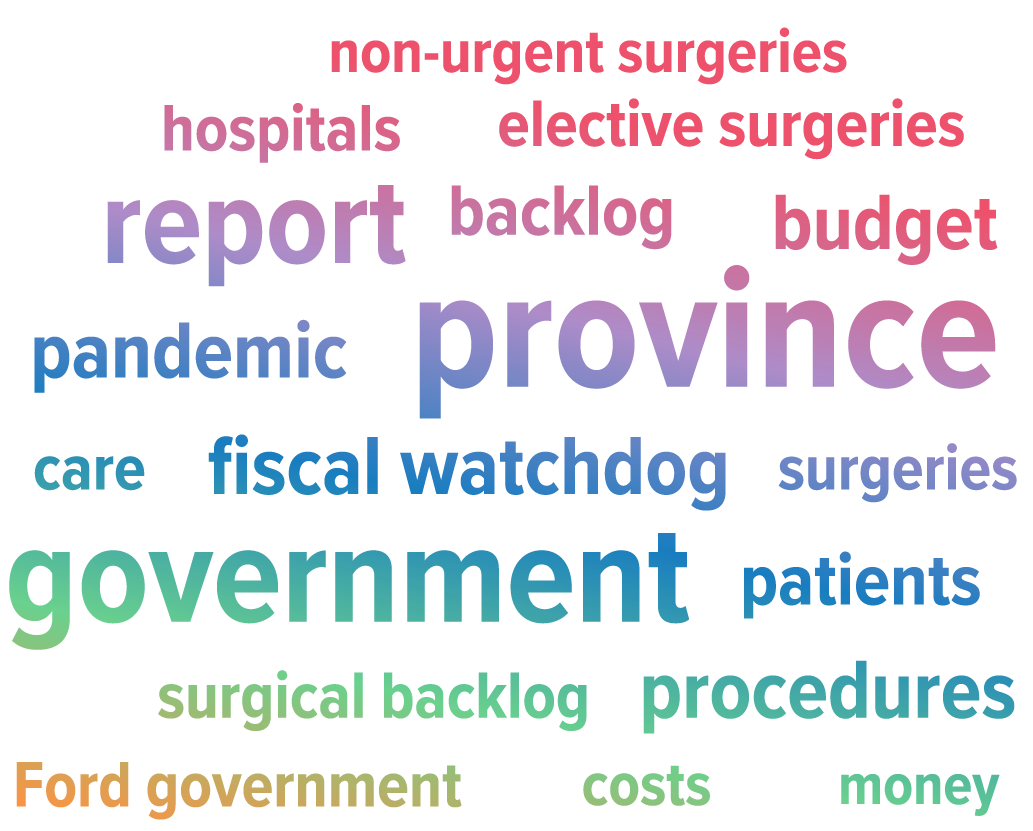
Figure 3: Media hits across Canada
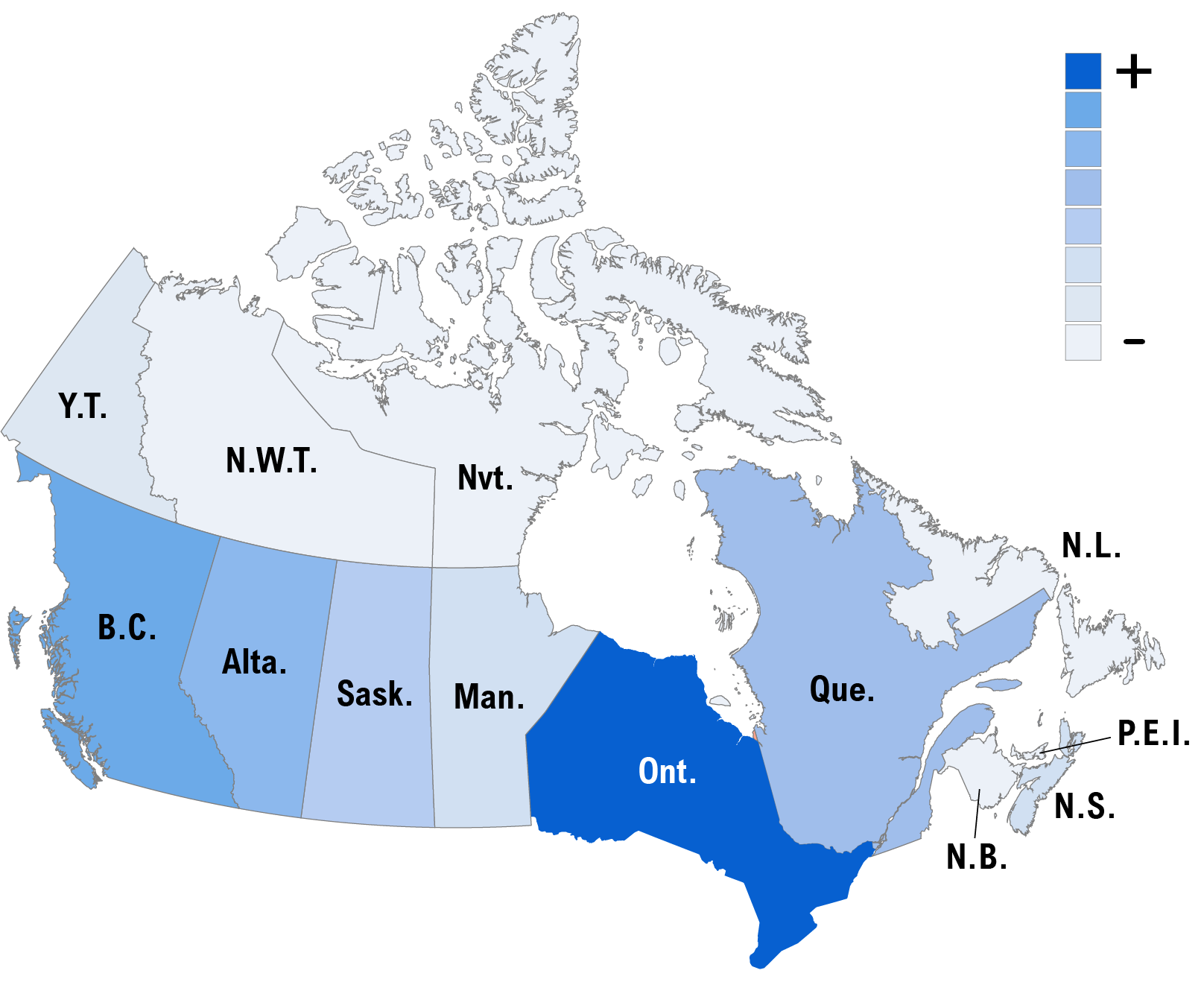
Social Media
In an age where most conversation occurs online, it is critical for organizations to have a presence where they can engage in real time with the public. For the FAO, that means selecting platforms that reach our target audience. Although Twitter does not provide organizations with demographic data about its audiences, the platform has a massive following, including MPPs, media and constituents. LinkedIn allows the FAO to build credibility and create a network of experts and individuals in similar industries. With a focus on photo and video content, Instagram can help boost brand awareness and reach a younger audience.
Across all FAO social media platforms, followership has been steadily increasing since their launch. When looking at year-over-year growth, Twitter followers increased by 18 per cent (Figure 4), while LinkedIn followers increased by 55 per cent (Figure 5) and Instagram followers by 75 per cent (Figure 6). Members of the public are also able to subscribe to the FAO’s news alerts to receive updates on reports; the number of the subscribers increased by 16 per cent in 2021-22 over 2020-21 (Figure 7).
Figure 4: Twitter Followers
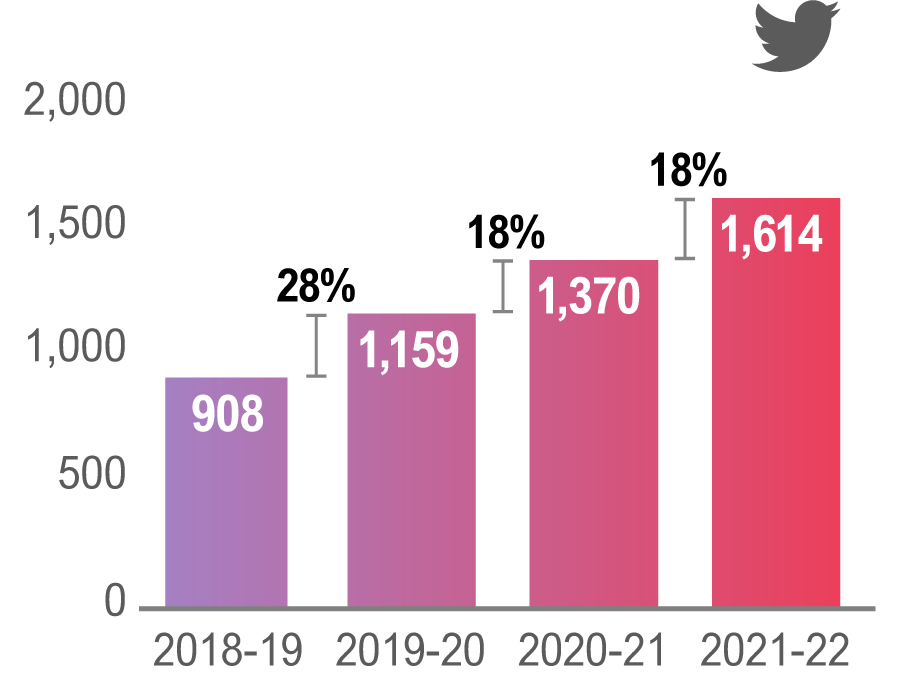
Figure 5: LinkedIn Followers
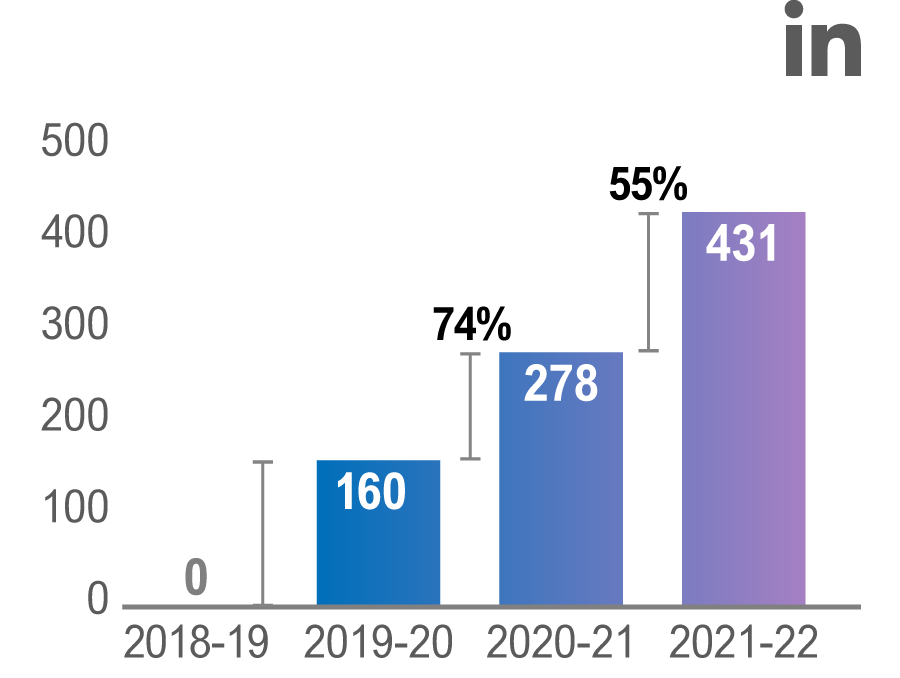
Figure 6: Instagram Followers
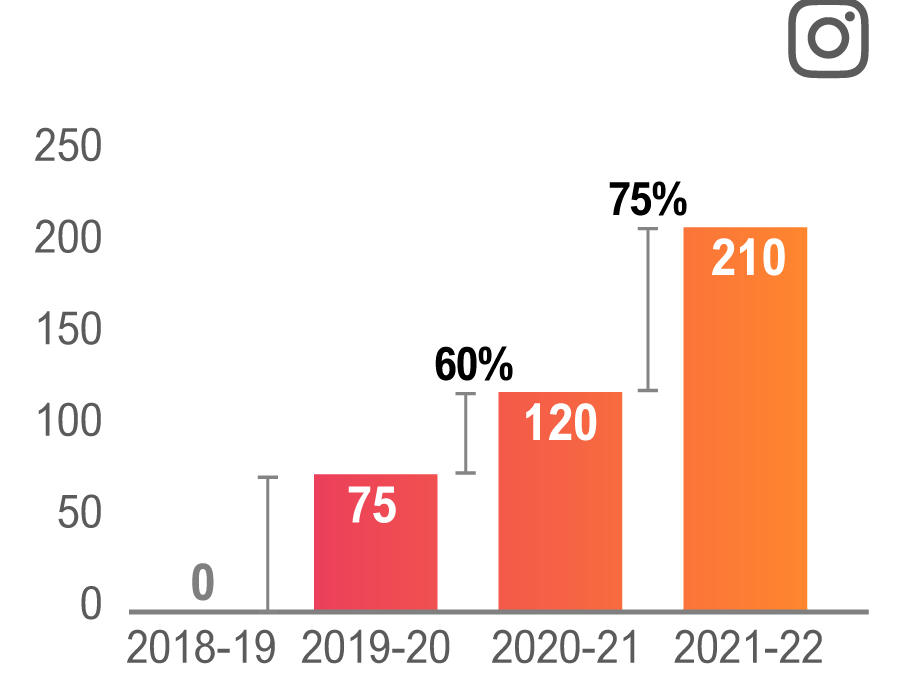
Figure 7: Email Subscribers
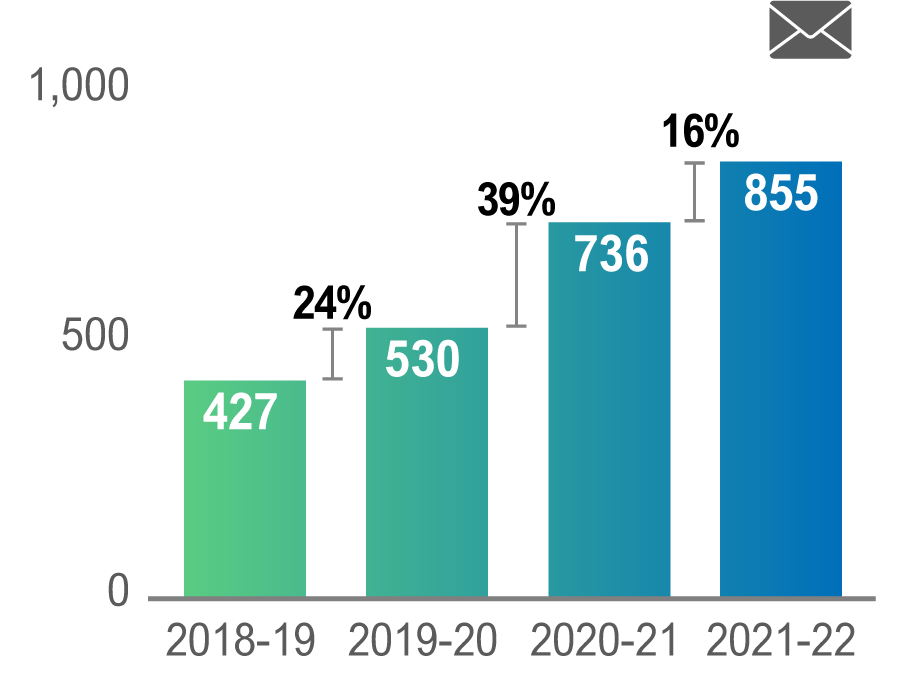
Figure 8: @InfoFAO Mentions
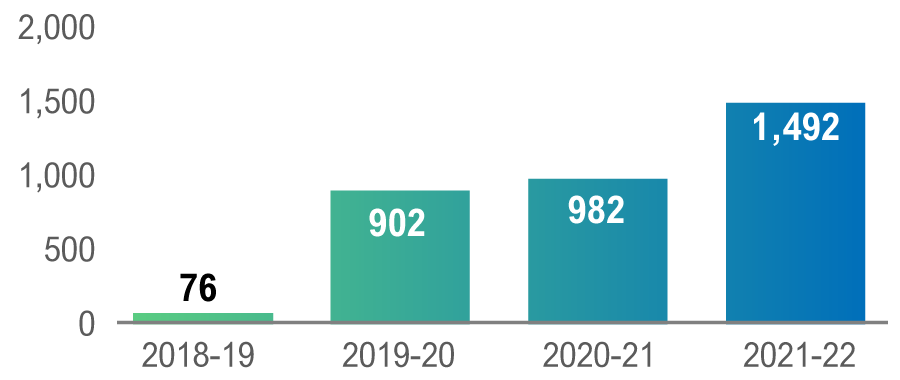
Twitter is the main platform that the FAO uses to disseminate information. In 2021-22, there were 1,492 direct mentions of the FAO’s handle, @infoFAO (Figure 8), up from the previous year. Importantly, mentions of the @infoFAO Twitter handle only account for a small portion of FAO references on Twitter.
This year, the FAO tracked new metrics through social listening, which garnered over 30,000 mentions of various iterations of “FAO,” “Financial Accountability Office” and “Peter Weltman” (Figure 9). Social listening refers to tracking social media platforms for mentions and discussions around an organization’s brand. These can then be analyzed to determine the context in which FAO reports are used and the sentiment around the topics, and to ensure that our work and the office are seen as neutral and non-partisan. This was reflected in the data spikes seen in September 2021 with the release of our Expenditure Monitor 2021-22: Q1, detailing government spending in the first quarter of the second full year of the pandemic, and in March 2021, with the release of our Expenditure Monitor 2021-22: Q3, which provided information on spending by the Province over the first three quarters of the 2021-22 fiscal year.
Figure 9: Social Listening
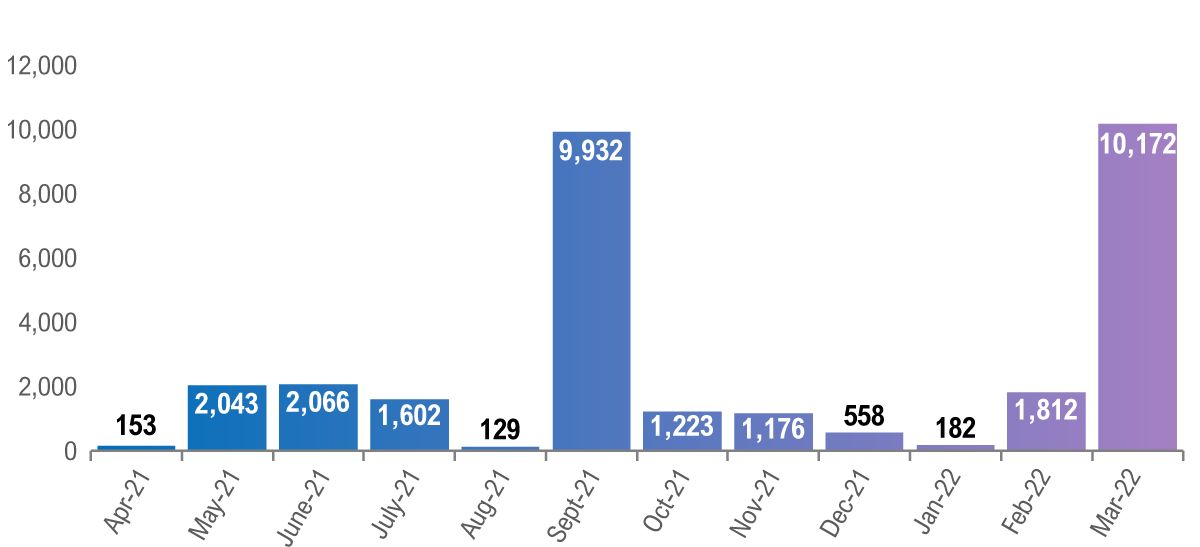
The FAO’s LinkedIn platform draws an audience comprised of individuals in the finance (16 per cent), community and social services (10 per cent), business development (9 per cent), and accounting (6 per cent) sectors, in line with the type of work that the FAO conducts. Additionally, the FAO’s LinkedIn audience tends to be more experienced, with the majority being “senior” (36 per cent), “director” (10 per cent), and “manager” (5 per cent).
On LinkedIn, longer thought pieces and personal posts like the FAO’s “Meet the Team” series performed best. LinkedIn users look for posts that are professional, helpful, and informative,[1] which the FAO’s LinkedIn strategy reflects, particularly in the articles published on the platform written by the Officer.
Website
The FAO’s website continues to draw the highest number of engagements among the general public, with a record 197,278 unique page views in 2021-22 (Figure 10). The FAO’s most popular report was a review of the impact of COVID-19 on hospital capacity. While originally published in 2020, the report continued to gain traction, with 12,789 unique views this year. FAO reports on housing and homelessness programs, the Ministry of Health’s spending plan, the provincial labour market in 2020, and the Expenditure Monitor 2021-22: Q3, rounded out the top five most viewed reports in 2021-22 (Figure 11).
Figure 10: Unique Website Views

Figure 11: Top 5 Reports in 2021-22
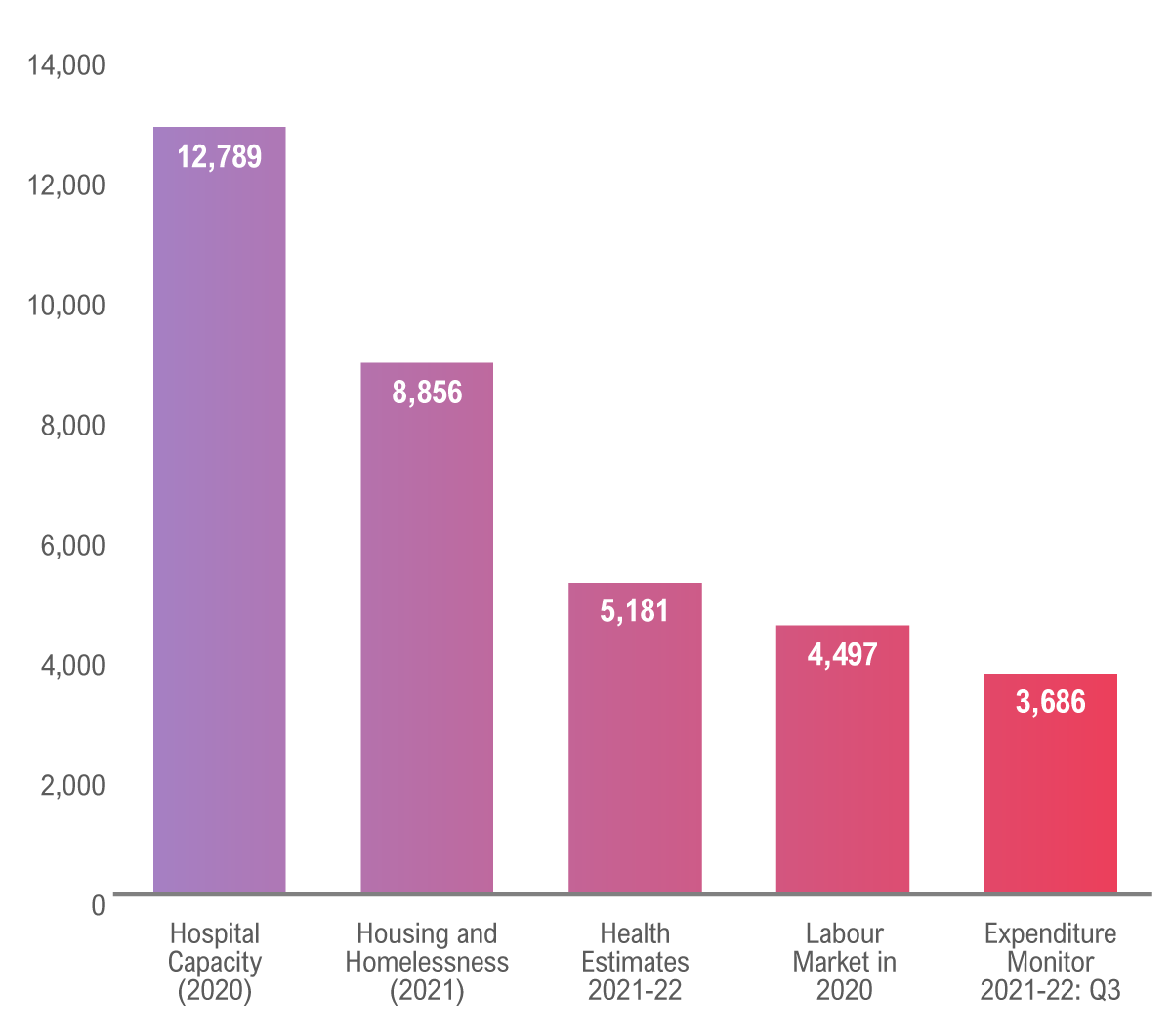
ACCESS AND DISCLOSURE OF INFORMATION
Access to Information
Access to government information is a key requirement for the FAO’s work, forming the base content for economic and fiscal analysis in support of the Legislative Assembly. In 2021-22, the FAO continued to maintain its professional working relationship with the executive branch, including ministries and other public entities, with each helping to provide the FAO with timely access to all requested information as legally required.
Ministries and public entities have a statutory duty to provide the FAO with information that the Officer believes necessary to perform his mandated duties, subject to only limited exceptions. In addition, recent Executive Councils have provided the FAO with access to certain information contained in Cabinet records. The Executive Council presided over by former Premier Wynne and the first Executive Council presided over by Premier Ford, both provided the FAO with access to relevant Cabinet records through two orders in council. On June 24, 2022, a newly appointed Executive Council, presided over by Premier Ford, was announced. In order for the FAO to obtain relevant Cabinet records from this new Executive Council, a new order in council authorizing the release of applicable records is required.
As of the writing of this Annual Report, the FAO anticipates that the new Executive Council will authorize the release of relevant Cabinet records to the FAO. Without access to government information, especially Cabinet records, the FAO could not operate at current levels, both in terms of number of reports produced and the quality of analysis in many of its reports. As such, it is important that all MPPs understand the relevance and value that this information brings to the legislature’s ability to hold the government to account.
Disclosure of Information
Although the FAO has access to a wide range of information, the Financial Accountability Officer Act, 2013, and the orders in council place important restrictions on the FAO’s ability to disclose government information.
Accordingly, the FAO has put in place internal processes that ensure information subject to these restrictions is not disclosed. As part of these processes, ministries and public entities provide advice to the FAO, which helps ensure that the FAO complies with its disclosure restriction obligations.
FINANCIAL STATEMENT
Financial figures are rounded to the nearest dollar and are prepared on a modified cash basis. The figures for 2018-19 through 2020-21 are taken from the Public Accounts of Ontario.
| 2021-22 $ (Unaudited) |
2020-21 $ (Unaudited) |
2019-20 $ (Unaudited) |
2018-19 $ (Unaudited) |
|
|---|---|---|---|---|
| Approved Budget | 3,966,700 | 3,850,000 | 3,711,000 | 3,384,000 |
| One-time transfer | 88,000 | 16,791 | ||
| Expenditure | ||||
| Salaries and wages | 2,552,552 | 2,736,481 | 2,383,145 | 1,827,927 |
| Employee benefits | 540,587 | 518,913 | 397,639 | 327,273 |
| Transportation and communication | 14,902 | 9,225 | 17,076 | 41,915 |
| Services | 717,630 | 644,889 | 873,536 | 727,558 |
| Supplies and equipment | 35,486 | 28,111 | 56,395 | 76,421 |
| Total Expenditure | 3,861,157 | 3,937,619 | 3,727,791 | 3,001,094 |
| Unused Appropriation | 105,543 | 381 | 0 | 382,906 |
THE YEAR IN REVIEW: 2021-22

The Year in Review: 2021-22
MPPs
In 2021-22, the FAO was mentioned 154 times in the Ontario Legislature; in other words, 49 per cent of all sitting days included a mention of the FAO, down from 60 per cent in 2020-21. Critically, each political party used data from our reports to defend or scrutinize government policy, reflecting the FAO’s success in carrying out its mandate as a neutral, non-partisan office.
Stakeholders
In 2021-22, 24 publications cited the FAO including:
- Association of Southern African Schools and Departments of Public Administration and Management
- Canadian Medical Association Journal
- Review of Accounting Studies
- International Journal of Cancer
- Institute of Public Administration in Canada
In 2021-22, 10 notable organizations used data from FAO reports to strengthen their pre-budget submissions, including:
- Daily Bread Food Bank
- Elementary Teachers’ Federation of Ontario
- Ontario Chamber of Commerce
- Ontario Council of Hospital Unions
- Ontario Public Service Employees Union
General Public
Across all FAO social media platforms, followership has been steadily increasing since their launch. When looking at year-over-year growth, Twitter followers increased by 18 per cent, while LinkedIn followers increased by 55 per cent, and Instagram followers by 75 per cent. Members of the public are also able to subscribe to the FAO’s news alerts to receive updates on reports; the number of these subscribers increased by 16 per cent in 2021-22 over 2020-21.
The FAO’s website continues to draw the highest number of engagements among the general public, with a record 197,278 unique page views in 2021-22.





